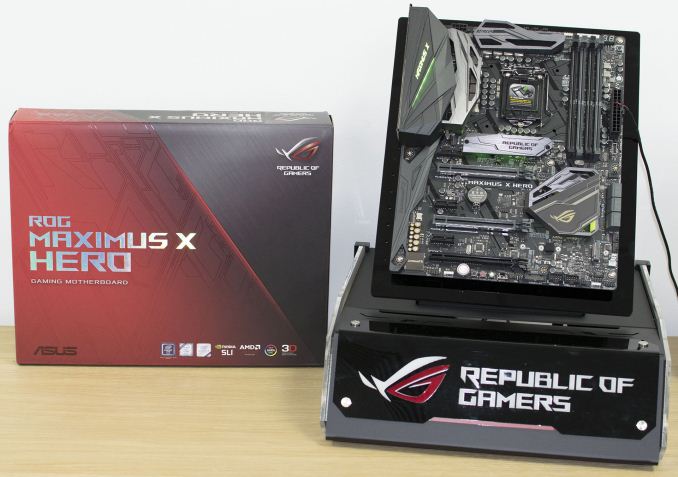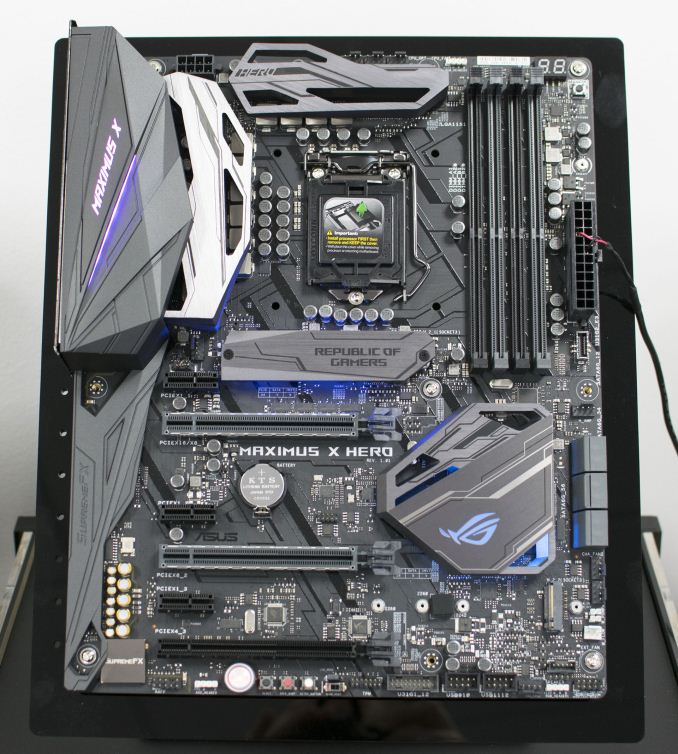Analyzing Z370 for Intel's 8th Generation Coffee Lake: A Quick Look at 50+ Motherboards
by Ian Cutress, Anton Shilov, Joe Shields & Gavin Bonshor on October 20, 2017 2:00 PM ESTASUS ROG Z370 Maximus X Hero
ASUS' Republic of Gamers brand has gone a slightly different route on the new Z370 chipset in that they are trying to make each of their ranges more distinguishable to the consumer. With any motherboard chipset refresh, it offers manufacturers the chance to refine their range thus hopefully improving on previous models and addressing concerns from the previous generation. The main differentiating features for ASUS this time around include a new clear-cut segmentation of their range of boards, a new heatsink design on the majority of the line-up, better memory support due to their 3rd generation T-Topology technology, and a slew of RGB customisable lighting/addressable RGB headers.
Starting off with what ASUS has touted as being one of their bestselling motherboards of the previous generation, the ROG Maximus X Hero slots in an interesting position as it doesn’t quite have the same clout as the Formula/Extreme boards have, but offers more features over the more mid-range Strix boards. There will be two Hero SKUs available with the only difference between both is one will come included with integrated dual antenna 802.11 AC Wi-Fi and one will be without. ASUS’s reasoning for doing this is simply a choice; giving consumers control over whether they want integrated wireless network capabilities or they want to save $15-$25 over something they think they won’t need.
The ROG Maximus range of boards is designed to exude the feeling of combining strong unique aesthetics with high-quality components to deliver strong performance in gaming and overclocking. The Z370 Maximus X Hero features a design with a huge emphasis on new metallic heat sinks that are an upgrade over the plastic heatsinks found on the Z270 version. Also along a theme is a single M.2 heatsink which features the ROG Logo etched in (the Z370 Hero has two overall M.2 slots available, this is in addition to six SATA 6Gb/s ports).
Two of the three full-length PCIe 3.0 slots feature metal shielding (which most manufacturers seem to have integrated into their more mid-range to high-end models), and are paired with three PCIe 3.0 x1 slots. The top slot and second slot operate at x16 and x8/x8 with the lanes being fed from the Coffee Lake processor, but the very bottom full-length PCIe 3.0 slot operating at x4 from the chipset. Both SLI two way and CrossFire three way are both supported by this board and the majority of day one launch Z370 boards from ASUS ROG.
Still touching on slots, the Hero has four memory slots, with a maximum capacity of 64GB of DDR4, and an official DDR4-4133 being supported. ASUS has implemented an Intel I219V gigabit Ethernet controller, which they report as having high reliability and performance, which is paired with Realtek ALC1220 audio codec which ASUS themselves call the SupremeFX S1220. On top of the codec, ASUS has enhanced the onboard audio on the Hero with an ESS Sabre ES9023P DAC. Another unique inclusion over the previous Z270 model is an integrated and pre-mounted I/O shield which ASUS claim as a patented technology.
A wave of cooling options and a slew of fan headers are dotted around the board including the more recent inclusion of a dedicated water cooling area. There is support for five 3/4 pin fans, including a high-amperage fan header, three thermal sensors with two of them being designed with water cooling in mind, in addition to a single flow header and two dedicated pump headers.
A plethora of rear I/O real estate should keep even the most gadget and peripheral hungry user happy with USB 3.1 10 Gbps in Type-A, Type-C and a stack of four USB 3.1 5 Gbps ports. You can run additional USB 3.1 and USB 2.0 ports from front panel header capabilities; a single header for USB 3.1 5 Gbps giving an additional two ports, an onboard USB 3.1 10 Gbps header, and dual USB 2.0 headers for a maximum of four additional ports. Finishing off the rear I/O is a clear CMOS switch, a BIOS Flashback button and DisplayPort/HDMI outputs for on-board graphics.
Other ancillaries include the two RGB strip headers, and a single addressable RGB header which has recently been supported by various manufacturers including BitFenix and Cablemods for use with ASUS ROG AURA SYNC software to allow for customisability and color matching between various supported components and peripherals.
It is very apparent that the Maximus X Hero is focused towards high-end gamers looking for a solution that covers support for water cooling, high-end performance Coffee Lake CPUs and high bandwidth and fast DDR4 memory. This allows users to feature a ROG Maximus range board with a lot of decent features, but without the hefty price tag of an Extreme, Formula or Code.













83 Comments
View All Comments
carldon - Saturday, October 21, 2017 - link
Excellent summary and table in the last page. Good work!!!imaheadcase - Saturday, October 21, 2017 - link
I got a few questions:1. Why do they put USB 2.0 ports if USB 3.0 is backward compatible anyways? Why not just all USB 3.0 ports..it can't be price.
2. Why do they have such a vary in memory timings? For %99 of people memory timings are not really a big deal right? Maybe in old PC days it was.
3. Mini-ITX vs Micro-ITX..isn't it silly both exist in first place? Any reason for this..the diminsions are really close to the same. In fact, most Micro-ITX is simply removing lots of stuff from mobo that you really want to begin with.
lordsutch - Saturday, October 21, 2017 - link
I'd imagine they want to offer as many ports as they can without taking away too many PCIe lanes. The other option would be to embed a USB 3.x switch (or a PCIe switch) but of course now each port wouldn't simultaneously be able to operate at peak speed and 3.x switches are probably more expensive than USB 2 controllers.imaheadcase - Sunday, October 22, 2017 - link
Ahh didn't think about that aspect.DanNeely - Saturday, October 21, 2017 - link
Some USB audio and 2.4ghz wifi/bluetooth devices have had interference problems in 3.0 sockets. Dunno if they're fixed on new hardware (supposedly onboard hubs were a lot worse than chipset ports in this regard so room for QC to make it better); but even if they are there's going to be problems with once burned customers not trusting them.As pointed out elsewhere USB3 competes with PCIe lanes/SATA ports on the southbridge. Especially on full ATX boards if you go to max out the number of PCIe lanes to expansion slots and m.2 ports in addition to the lanes used on board for networking and audio you can get down to only a half dozen or so 3.0 lanes left from the chipset; but still able to hit 14 USB ports total by going USB2 with the rest.
People using older OSes (Windows 7 says hi) can't use USB3 ports to install the OS without jumping through a lot of hoops (the OS sees them as not USB2 and can't talk to them).
If any board size is at risk of going away it's probably full ATX; although for enthusiast sales I suspect it'll hold on better than mini ATX due to bigger is better irrationality.
MiniITX still has a decent capability gap vs mini ATX; but it's much smaller than it was a half dozen years ago when it only made sense if you were making a tiny box and were willing to accept major performance compromises to do so. Now as Mini ITX's capability continues to goes up and the need for expansion cards other than a single GPU goes down it's eating into an increasing chunk of Mini ATX's marketshare.
On the high side mainstream chips don't really have enough PCIe lanes to make good use of the extra 3 cards of space possible on the bigger boards/ Meanwhile multi-GPU gaming - the main reason an enthusiast would need a full size mobo is steadily going away (fewer games supporting it each year, no support for 3/4way at all in the newest cards from either company); and unless you need 2 GPUs + something else or extra space around the CPU for crazy OCing Mini ATX does almost everything that could be needed.
MadAd - Sunday, October 22, 2017 - link
> If any board size is at risk of going away it's probably full ATX; although for enthusiast sales I suspect it'll hold on better than mini ATX due to bigger is better irrationality.Irrationality indeed. I would have thought by now instead of a measly 5 mATX choices out of 50+ that it would be instead maybe 5 fullsize ATX with the main battleground being the two slot mATX market.
Its just laziness on the manufacturers side, with nobody steering the market to innovate on size. Theres nobody driving form factors, the CPU companies are present on all form factors so they dont need to drive change, the board partners are all set in their ways just slapping new images on mildly reworked designs so they dont have any need to innovate, weve seen video card manufacturers can shrink designs to better fit smaller factors but we still get chunky easy to produce cards for mainstream use as retooling would be an added cost, its just rolling train of new but nothing new generation after generation.
PC design is falling into mediocrity and I just wish the main players (intel+amd/board partners/nvidia+amd) would all get together to drive SFX/ITX and force retire ATX to the strictly enthusiast market, and maybe appeal to a more contemporary home user community (rather than just gamers which is where the marketing all seems to be these days) again too.
Liltorp - Saturday, October 21, 2017 - link
It is really true that the MSI PC Pro has a legacy PCI connector? I could use this for my TV tuner. But I thought PCI was not supported by newer boatds/CPU`s?Morawka - Saturday, October 21, 2017 - link
Has anyone noticed how cheap these new Z370 motherboards are? Most are under $180 and there are several sub $130.IGTrading - Sunday, October 22, 2017 - link
Tell this to the guys that already spent money on non-Z370 just a few months ago.Intel is already screwing them.
It would have been funny to sell a 250 USD motherboard to a 7700K buyer just last month, telling him his 250 USD are a good investment because of the good upgradeability.
Just 4 weeks later tell him: "Well ... Yeah ... About that upgrade ... It will cost you a minimum of 110 USD extra + the 360 USD for the new 8700 K.
775 was the last good & long lived platform from Intel.
edzieba - Sunday, October 22, 2017 - link
If people brought Z370 boards expecting them to support an additional CPU generation, they did it in spite of every Intel CPU release for the last decade: two CPU gens socket generation. There's no counter to ignoring the past.